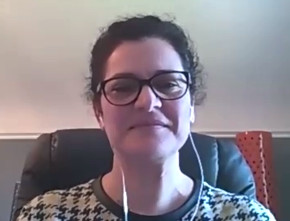Dr Harriette Van Spall, associate professor in the Division of Cardiology at McMaster University, scientist at the Population Health Research Institute, and cardiologist at Hamilton Health Sciences, answers questions from Dr Roman Jaeschke on the role of SGLT-2 inhibitors in heart failure treatment.
Roman Jaeschke, MD, MSc: Good evening. Welcome to another edition of McMaster Perspective. I would like to introduce our expert in heart failure, Dr Harriette Van Spall, associate professor in McMaster University’s Department of Medicine and one of the leading cardiology or heart failure researchers—for sure in Canada, if not around the world.
Harriette, where I would like to start is that the impetus for this series of interviews was what I perceived as a revolution in the treatment of heart failure. We’ll be talking about effects of all these small revolutions on the overall picture of heart failure. But maybe let’s start with the “newest kid on the block,” the newest type of medication, which is sneaking on us with incredible force: the sodium-glucose cotransporter 2 (SGLT-2) inhibitors. Where is it coming from, how did it start, and where does it lead us? The floor is yours.
Harriette Van Spall, MD, MPH: The background is that SGLT-2 inhibitors have been tested among patients with cardiovascular risk factors and have been found to improve cardiovascular and renal endpoints as well as heart failure hospitalizations. This led to the DAPA-HF (Dapagliflozin and Prevention of Adverse Outcomes in Heart Failure) trial, which tested the efficacy of the SGLT-2 inhibitor dapagliflozin among patients with heart failure with reduced ejection fraction (HFrEF).
The results of this trial were presented about a year ago. It showed that among 4700 patients with HFrEF—defined as patients with an ejection fraction (EF) <40%, symptomatic heart failure with New York Heart Association (NYHA) class II to IV symptoms, as well as elevated N-terminal pro–B-type natriuretic peptide (NT-proBNP) levels—dapagliflozin at a dose of 10 mg once a day reduced the primary composite endpoint of cardiovascular death and heart failure hospitalization with a hazard ratio of 0.74 after about 2 years of follow-up. This benefit in the primary composite outcome was seen regardless of whether patients had diabetes…
Roman Jaeschke: Because these were antidiabetic drugs to start with. As a cardiologist, you’re interested in the cardiovascular [aspects], but I think they were introduced as antidiabetic drugs.
Harriette Van Spall: That’s right. In the background history leading up to this trial, the SGLT-2 inhibitors were considered hypoglycemic medications and they were tested among diabetic patients with cardiovascular risk factors. Here for the first time the medication was introduced to patients regardless of whether they had diabetes. They had to have a diagnosis of HFrEF…
Roman Jaeschke: HFrEF meaning? For those of us who are less initiated.
Harriette Van Spall: Heart failure with reduced ejection fraction.
Roman Jaeschke: That’s for us, mortals.
Harriette Van Spall: As long as patients did not have severe kidney disease, which was defined as an estimated glomerular filtration rate (eGFR) <30 mL/min/1.73 m2, or symptomatic hypotension. Of course, patients were excluded if they had type 1 diabetes.
As I mentioned, the benefit of the drug was seen regardless of diabetes status. In subsequent sensitivity and subgroup analyses it was also shown to be effective regardless of the type of background medical therapy and the diuretic dose that patients were on.
Across several subgroups of patients and background therapies dapagliflozin at a dose of 10 mg a day—so a drug that does not need to be uptitrated—was of tremendous benefits to patients with HFrEF.
Roman Jaeschke: Do we know how it works? It was to be introduced as a glucosuric drug, diuretic, antihypertensive, but this result… There was a 2.5% decrease in overall mortality over a course of several months. It’s almost too good to be true.
Harriette Van Spall: Right. The exact mechanism is not entirely clear, but it may have… It has a bit of a diuretic effect, anti-inflammatory effects, and of course it works on the SGLT-2 channel. So the effects are multifactorial and are still being teased out.
This drug should be considered in symptomatic patients with HFrEF who are on optimal guideline-directed medical therapy, so a background of angiotensin receptor–neprilysin inhibitors (ARNIs), beta-blockers, and mineralocorticoid-receptor antagonists (MRAs), who despite being on those therapies at target dose are still symptomatic. They should not be used in patients with type 1 diabetes or patients who are hypotensive, hypovolemic, or who have significant renal disease. It’s important to carefully follow volume status, as they have a bit of a diuretic effect. In some patients you may need to decrease the dose of your loop diuretic.
It’s also important to review potentially adverse outcomes or effects in patients. In DAPA-HF the adverse effects were similar to the placebo group, but in other trials SGLT-2 inhibitors have had some adverse reactions that patients should be privy to. These could include general and urinary infections, and of course hypoglycemia. In patients who are volume depleted or in type 1 diabetics it can cause diabetic ketoacidosis. In the case of canagliflozin, which is a different SGLT-2 inhibitor that has not been tested in HFrEF, patients should be cautious if they are on digoxin, because coadministration can increase plasma digoxin levels. It’s something to bear in mind as a drug-drug interaction.
That’s sort of a bird’s eye view of the DAPA-HF trial.
Roman Jaeschke: I have one more question. You are one of those people who has a reputation of uptaking new ideas early.
Harriette Van Spall: You’re very kind.
Roman Jaeschke: Are SGLT-2 inhibitors part of practice guidelines yet? Or what are your predictions about what will happen?
Harriette Van Spall: Yes, they have been incorporated into the updated Canadian guidelines, but they haven’t yet been approved by Health Canada for use in HFrEF in the absence of diabetes. We’re certainly using it among diabetics with cardiovascular risk factors, diabetics who have established cardiovascular disease, diabetics with HFrEF.
I have to admit there have been some off-label uses in patients who have symptomatic heart failure. We expect approval anytime soon. It has been approved in the United States by the Food and Drug Administration (FDA). They are the early adopters of drugs. We typically find drugs are approved in the United States before they’re approved here.
Roman Jaeschke: Thank you very much for this segment. I appreciate it. We’ll talk about the other building blocks of heart failure treatment in the next segment. Thank you.
Harriette Van Spall: My pleasure. Thank you.
 English
English
 Español
Español
 українська
українська










